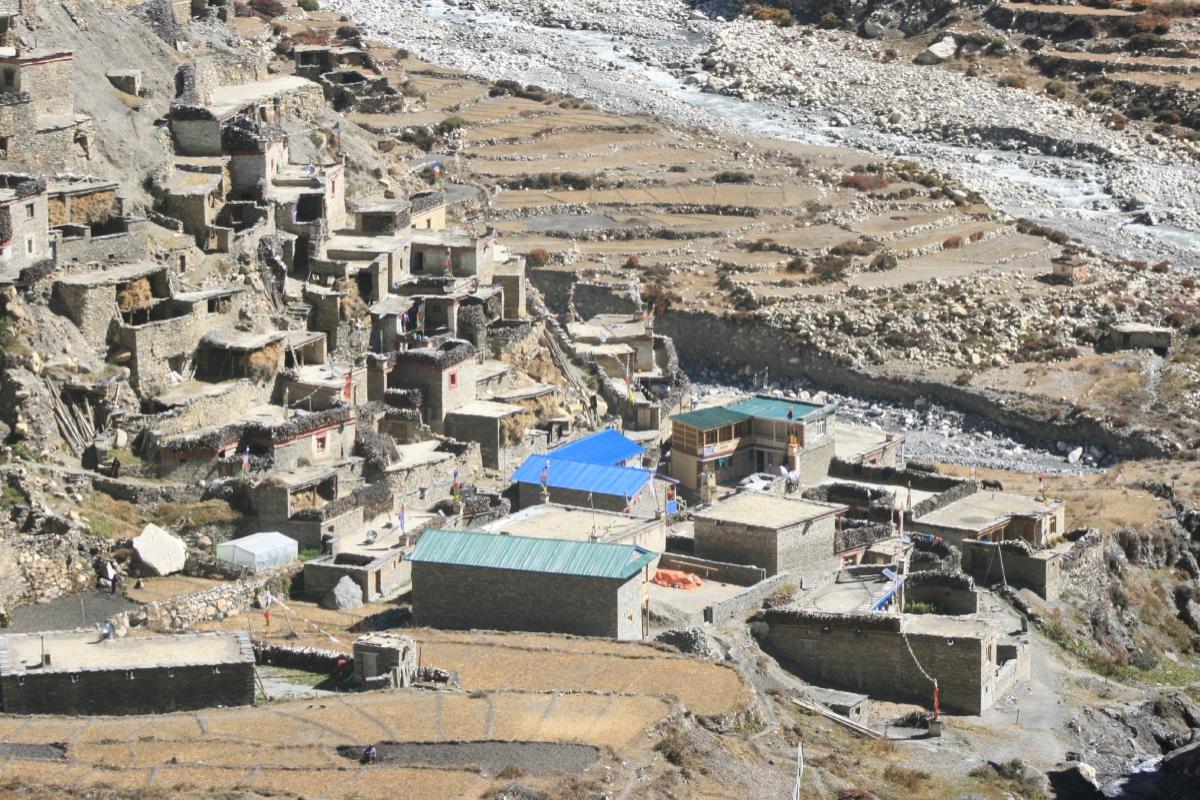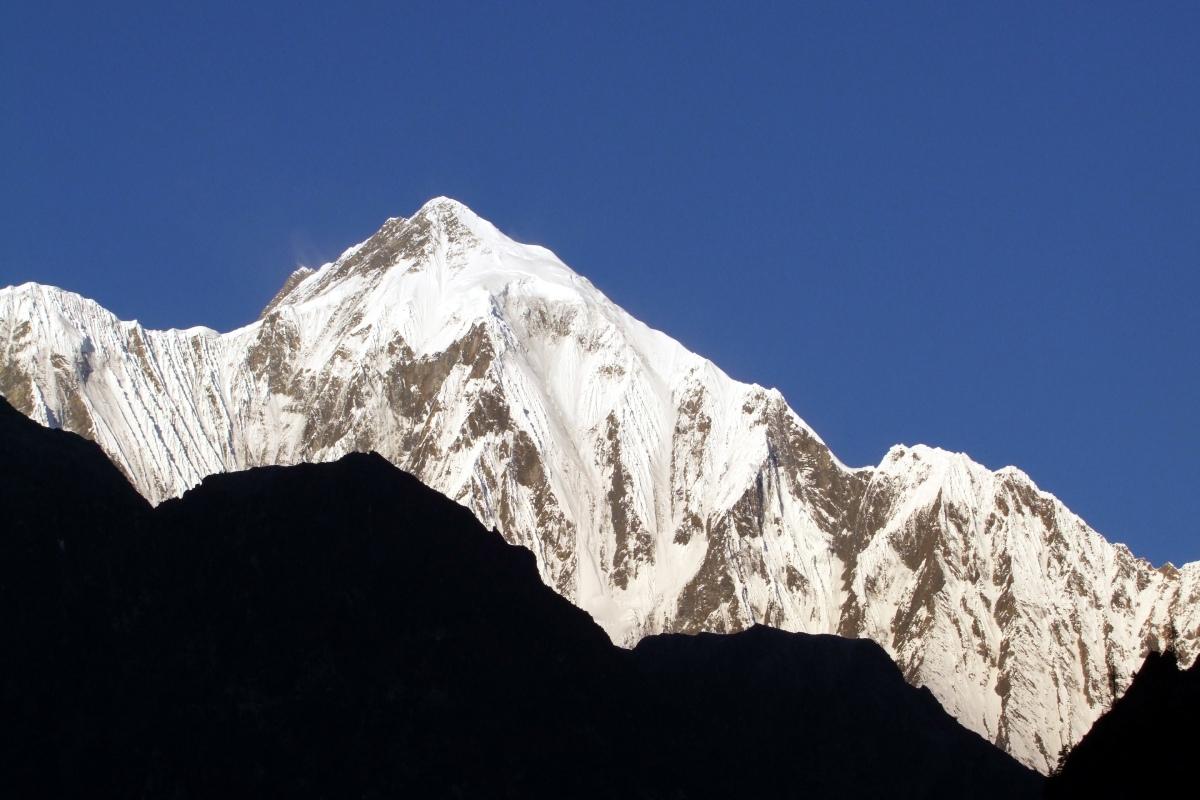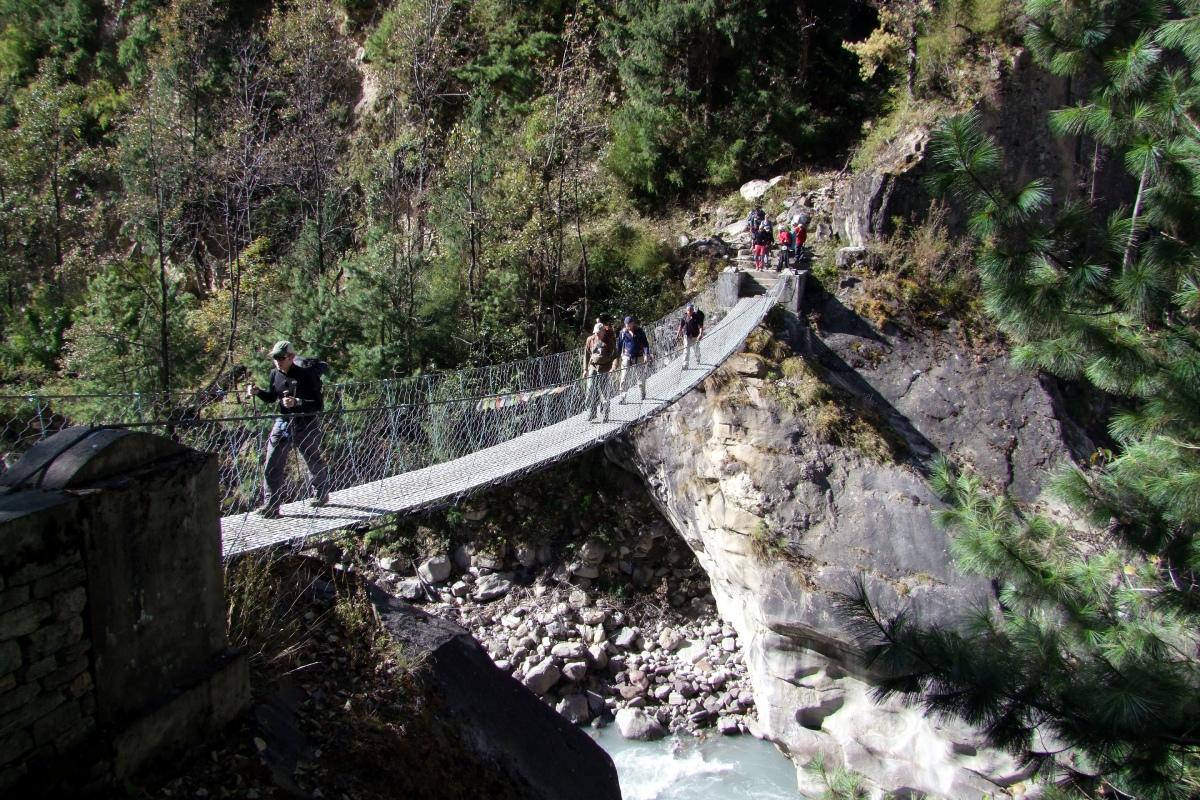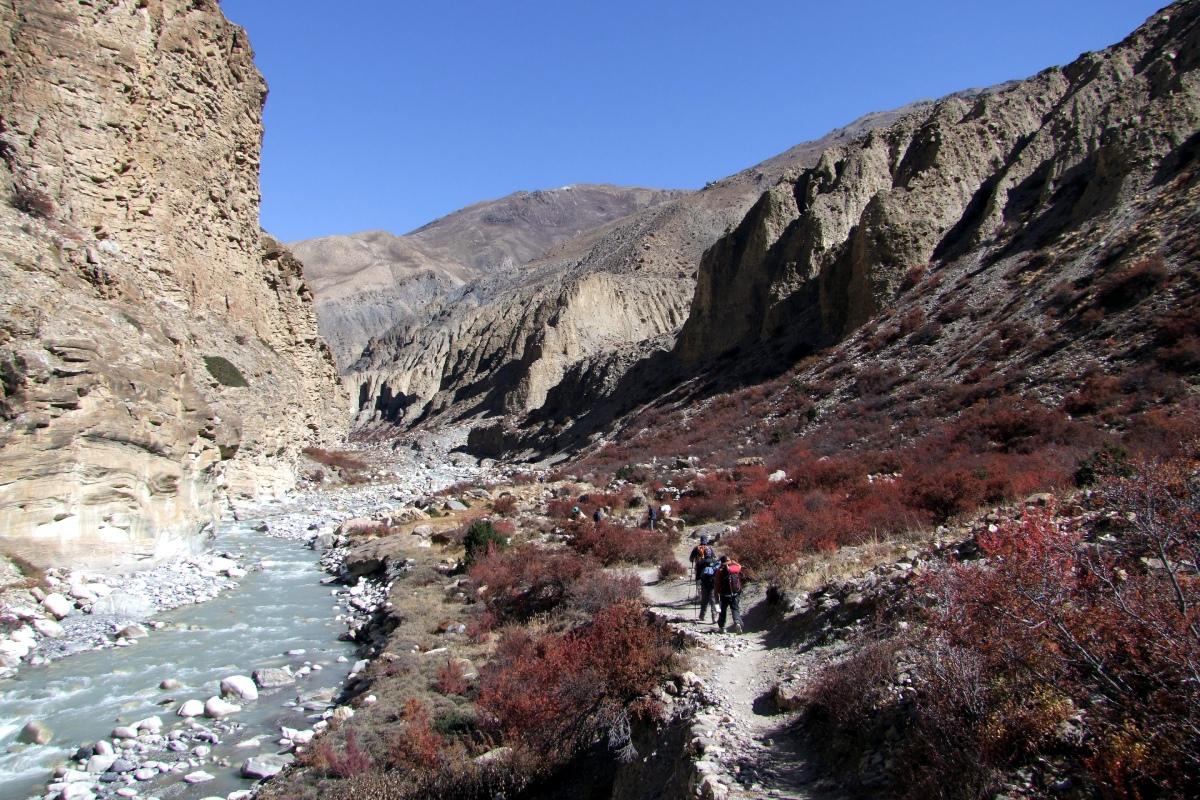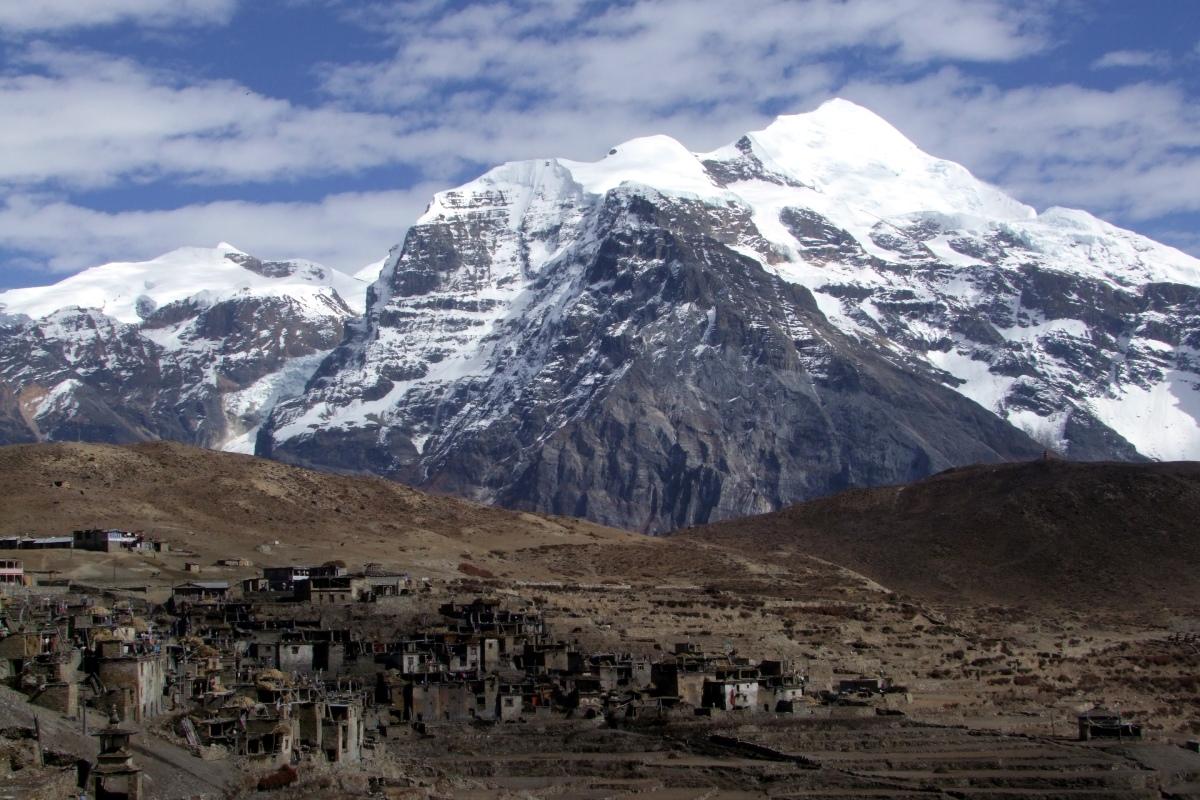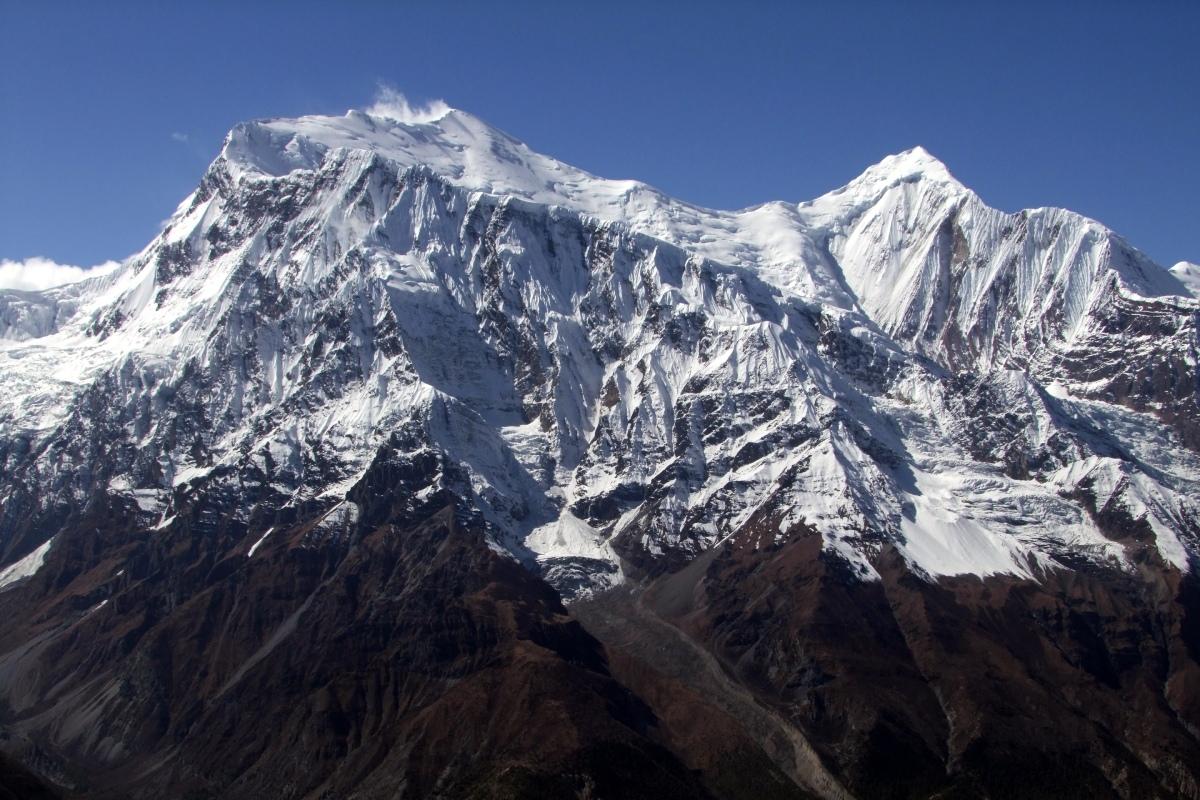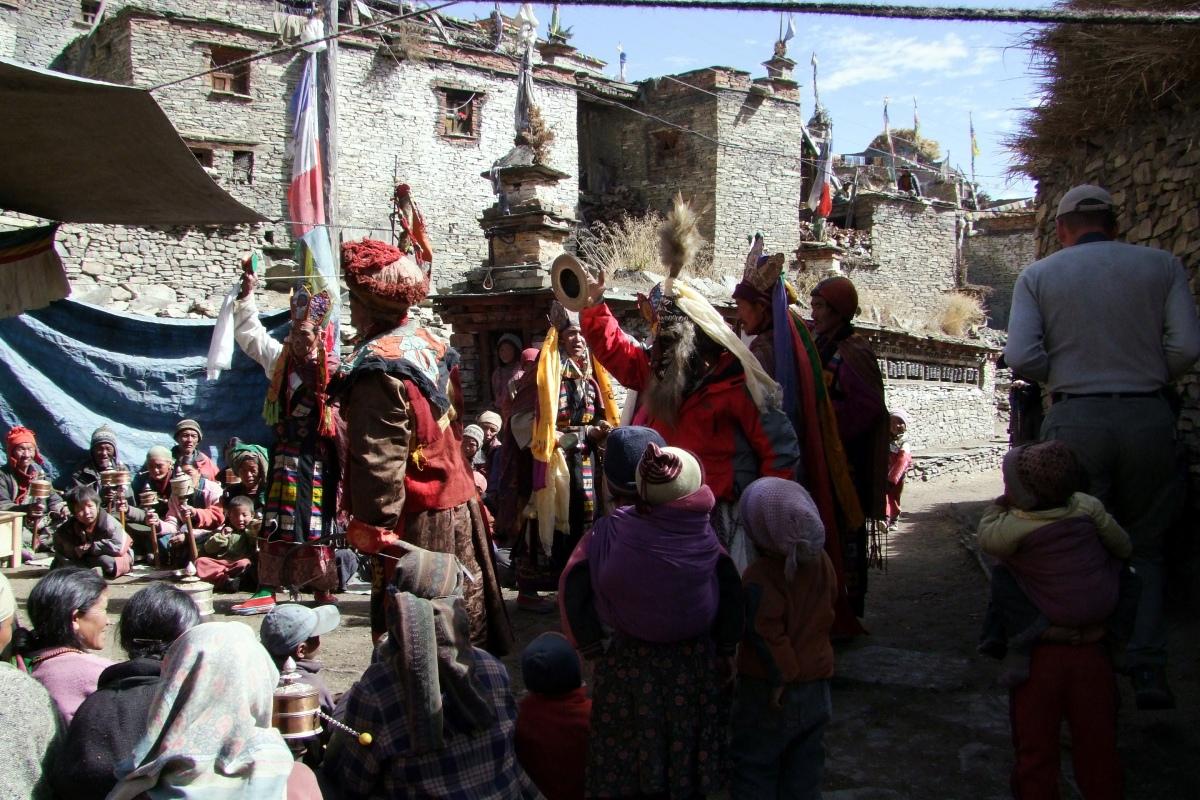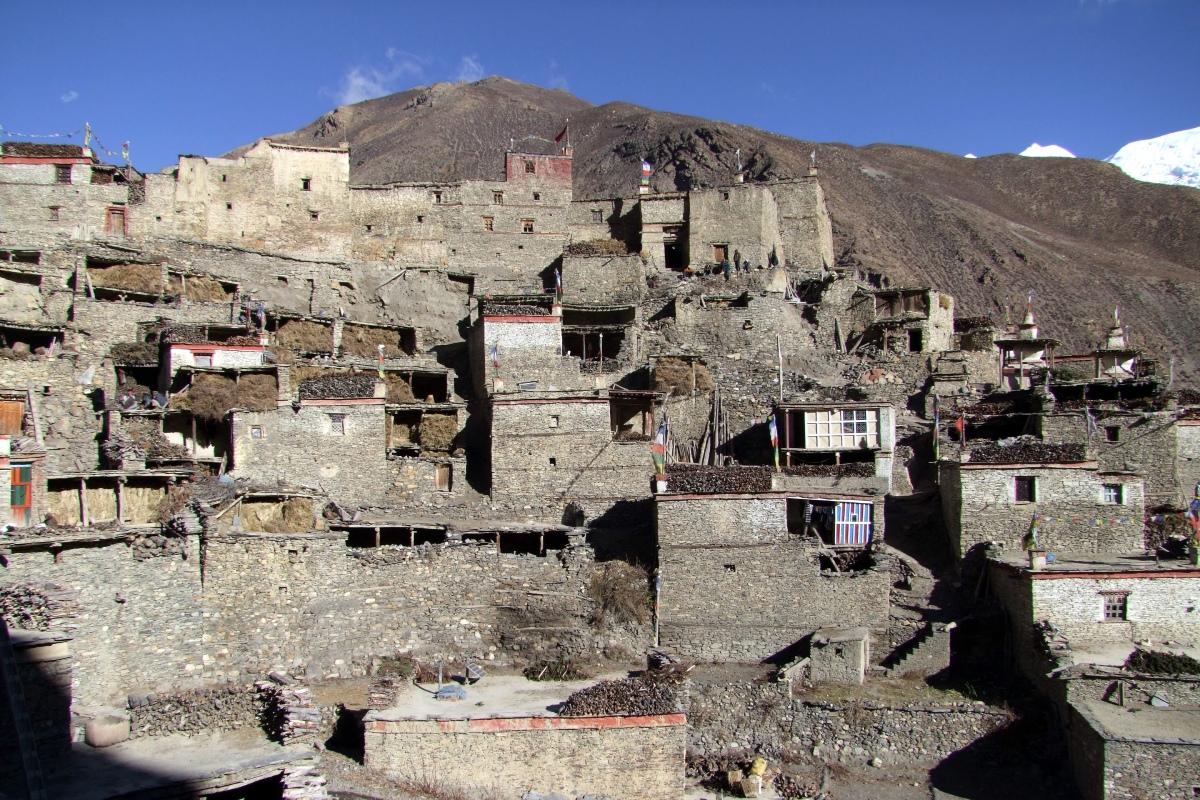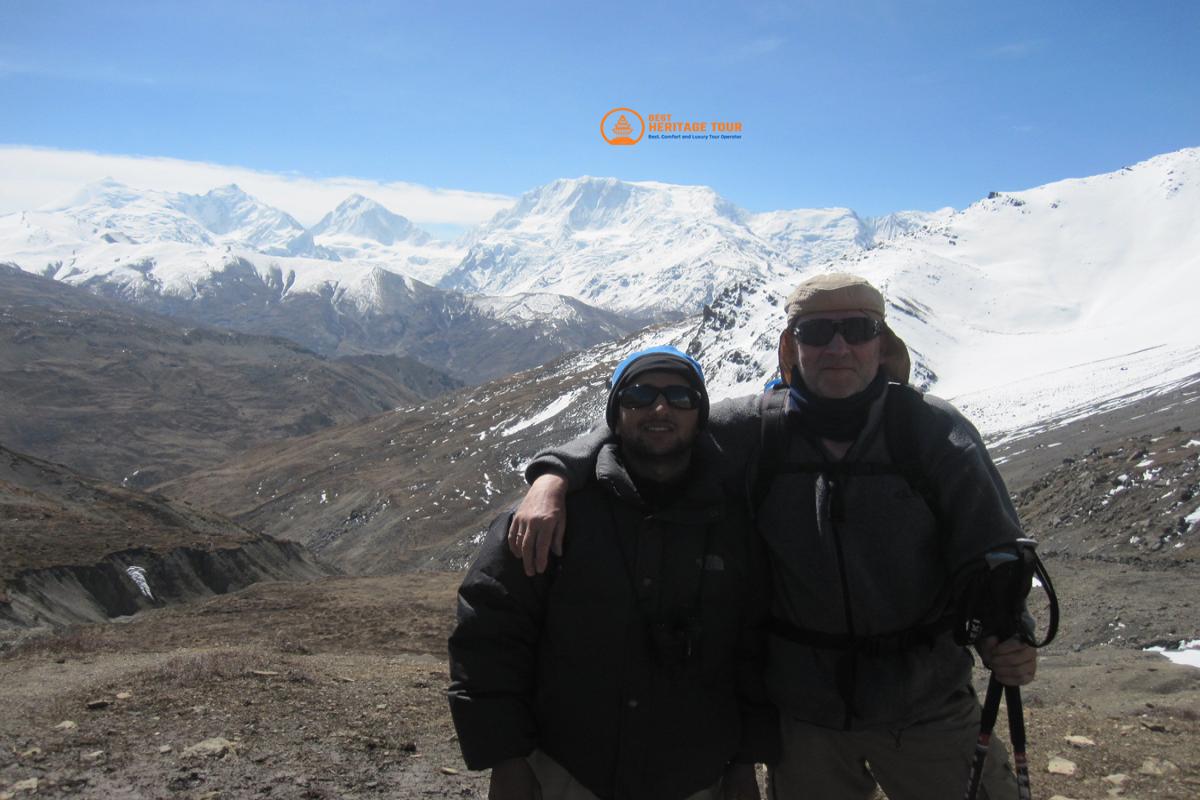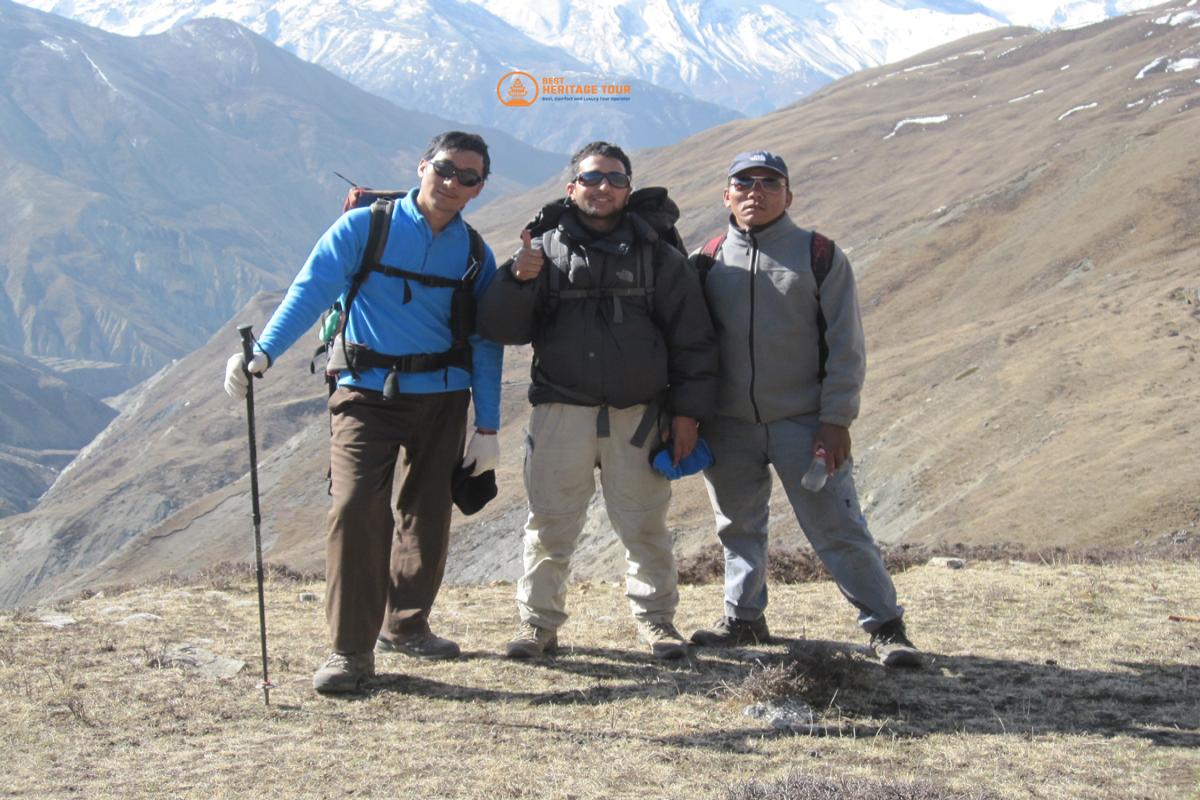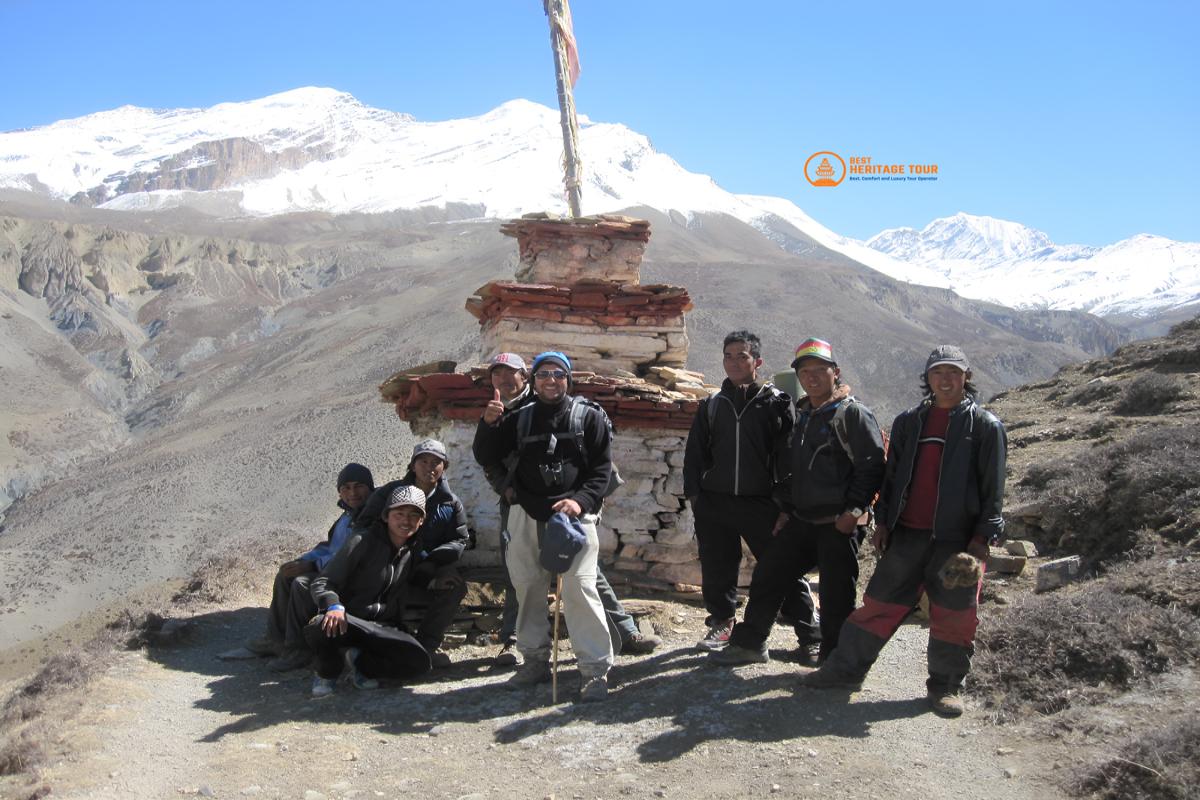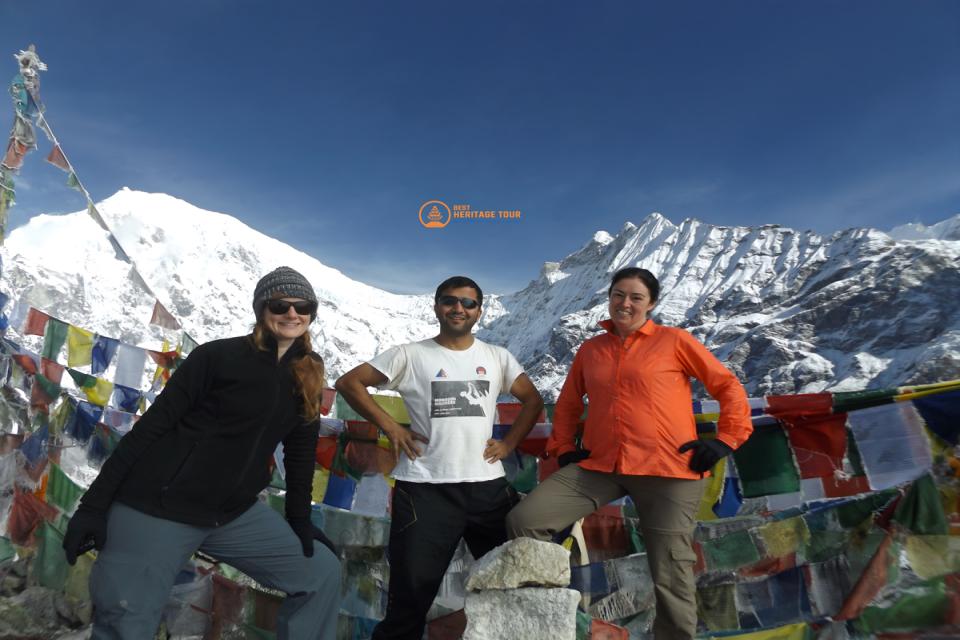Nar Phu Valley Short Trek - 9 Days
Insight on Nar Phu Valley Short Trek
The Nar Phu Valley Trek offers a deeply immersive experience, blending adventure, culture, and nature. You’ll trek through remote villages, staying with locals and witnessing traditional Tibetan life, untouched by modernity. The journey takes you through rugged landscapes, with breathtaking mountain views and the thrill of crossing high passes like Kang La. The valley’s solitude and quiet beauty make it a perfect escape from the crowds. Along the way, you’ll encounter ancient monasteries, colorful prayer stones, and the possibility of spotting rare wildlife, including the elusive snow leopard, all while exploring a region rich in history and culture.
Trip at a Glance
Key Highlights
- Explore the remote Himalayan ranges of Nepal and the adjacent Tibetan border.
- Stay in local people's homes and experience the century’s old untouched culture of Gumba.
- Experience an exciting drive over Kang La Pass (5,320m) with breathtaking views.
- Experience panoramic views of Annapurna, Manaslu, Himlung Himal, Gangapurna, and Kangar Himal.
- You might get a chance to catch a glimpse of the endangered snow leopard.
- Experience the culture of Tibetan origin with colorful prayer stones, chortens and monasteries.
- A perfect trip to get away from the crowds and groups of hikers.
Benefits of Nar Phu Valley Trek with Best Heritage Tours
- Easy booking and reservation system
- Online Travel Briefing after booking confirmation
- Diverse communication options available (email, WhatsApp, Facebook, WeChat, Viber, Skype, Zoom)
- 24/7 phone contact +977-9851149197/+977-9810043046
- Simple payment system.
- Free airport transfer on arrival/departure to hotel by private vehicle
- Oximeter and other medical kits for monitoring blood oxygen at high altitudes for early detection of altitude sickness
- Sleeping bag and Trekking poles if you don't have one.
- Travel bag for porters
- Free excess baggage check at Best Heritage Tours store during the trek
Trip Overview
Just beyond the north face of Annapurna, in the Trans-Himalayan range, the Nar Phu Valley trek is a surprisingly short one. The Nar Phu Valley short trek offers a blend of sceneric views of nature, adventure, and cultural experience. Key features of the trek include impressive mountains, thrilling passes, glaciers, ancient remote villages, deep valleys with large rivers, beautiful forests, unique rock formations, herds of yaks and wild goats, Gombas, and the unique medieval Tibetan culture that has been passed down from the Tibetan people who became their ancestors. In 2003, Nar Phu Valley was officially opened to trekkers with a teahouse and private lodging concept. As this is a trek in a restricted area, you will need to obtain a special trekking permit from an accredited trekking agency. The trek begins in Koto village, diverging from the main path of Nepal's famous Annapurna Circuit, which leads to Chame, the capital of Manang, and further. The trail follows the seldom-hikered Nar Hora and then crosses the Marsyangdi River at Koto before entering the Nar Phu Valley Hikers quickly leave the busy trail and enter the peaceful Nar Phu Valley.
The path meanders through the forest, passing through narrow paths with occasional mountain views. The colorful Tibetan chortens, monasteries, prayer stones, rock art, and expansive meadows in Dharmashala make the journey worthwhile. We continue through Meta, Chaku and Kang to the Nar-Phu valley, where the remains of destroyed buildings recall the memories of the 1960s Khampa revolution of Tibetan rebels. From Phu village there are various detour options, including Tashi Kaling Gunba, Himlung Himal Base Camp (4,920m) and the sacred Damodar Kunda trail. In good conditions, well-prepared trekkers can go directly from Phu to Nar village, tackling the challenging route that includes Phu Pass (5,050m) and Nar Pass (5,400m).
After returning to Meta village, we visit Kangar Himal Base Camp (4,500m) before continuing to Nar Pedi and Nar village, and reaching Kang La Pass (5,320m). Kan La Pass offers 360-degree views of the Annapurna and Chulu ranges, Himlung Himal (7,176 m), Kangal Himal (6,981 m) and Lamjung Himal (6,983 m). Finally, the Kan La Pass short trek ends at Chame on the main trail of the Annapurna Circuit via Ngawal (3,675 m), from where you will return to Besisahar and continue to your destination. You can now drive a jeep directly from Ngawal to Besisahar. The journey takes about 10 hours.
A quick trip to Nar Phu Valley offers a chance to enjoy the rich culture and mountaineering of Nepal. This trek is affordable compared to other areas closer to Nepal. This 9-day Teahouse Trek is designed for hikers on a budget who want to see the high Himalayan Mountains quickly. Want to hit the beaten path of Nepal during the best season without getting caught up in hordes of other tourists? In this case, your key spots will be Nar Phu Valley, Short Tak, and Kangra Pass. Best Heritage Tour is happy to help you organize your trip at any time of the year and will provide you with expert local guides and porters. Autumn and spring are the best seasons for this trek. Nar Phu Valley is ideally visited during the monsoon season, as it is located in a rain-shadow region behind the Himalayas.
Itinerary
Our trekking guide will arrive at your hotel at 6:00 am and will take you to the bus station using private vehicle. Then drive to Besisahar (185 km). The trip will last around 5-6 hours along a beautiful route. During the ride, you will see stunning sights of snow-covered mountains, lush hills, rivers, and local villages. Then again drive by jeep or local bus for 4-5 hours from Besisahar to Chame via Nagdi, Bulbuhle, Sange, Chamche, Tohru, Dharapani, Bagarcha, Danakya, Timang, Tangchok and Koto for 66.5 km (2670 m). Timang (2720m) offers spectacular views of Manaslu, Annapurna II and other majestic peaks. From here the road continues through pine forests to Tangchok and finally to Koto. This location is close to Chame, the main town in the Manang district. It offers amazing sceneric views of Annapurna II, Manaslu, and Lamjung Himal, as well as two small hot springs. Overnight stay at a teahouse.
Today, we explore a new path on the Annapurna Circuit. A long and fairly difficult day awaits us today. We pass through the checkpoint, traverse the bridge leading into the Nar Phu valley, and stroll through the beautiful forests situated above the Phu Khola River. The trail passes through beautiful forest, past several small refuges (caves) and pilgrim shelters ("dharmasalas"). Approaching a narrow canyon, the trail passes under a wide waterfall just before the Dharmasala, from where the forest thins out. We spend the night in a teahouse in Meta.
After breakfast, we climb a picturesque small river valley, one of the most beautiful walks in the Himalayas. This will eventually bring us to the highland meadows, the winter settlement of Nar. The landscape resembles the Sierra Nevada: white rocks, scrub and juniper, scattered evergreens, delicate brick red and orange bushes, crumbling slate, white sandy roads and gnarled trees. The trail then passes through the semi-settled settlements of Meta, Junam and Chaco.
The "Khampas" from Tibet sometimes take refuge in their settlements. At the top right is a huge glacier dropping directly onto the highland pastures. After many more climbs and descents we reach today's Kayan campsite, where grass dries in clumps on the roofs and prayer flags flutter in the wind. The path then runs along the river bank for a while, where we can see unique and colorful chortens, Buddhist temples and the distinctive landscapes that Nar and Phu are truly famous for. The hike then continues through picturesque canyon landscapes and gorges, where the monolithic "Leaning Tower of Pisa" guards the steep path up to Phu Gate. From this gate, called Phupigyal Kwe, you get your first view of Phu's three villages. You can also view the ruins of the old "dzong" (fortress) and two other fortresses, all now in decay but strikingly located on the plain in front of Phu.
Walk around to explore Phu village. A unique culture has been preserved here, where people still make a living in traditional ways. Interact with locals and explore the vast valleys that stretch above. Engage with the villagers as they dedicate their day to spinning yak and sheep wool, engaging in conversation, grinding mustard seeds into a paste and oil, and participating in the various activities that characterize daily life in a Tibetan village. For photographers, the light here is fantastic and the skies are a deep blue. You might even spot a few blue sheep in the nearby hills. It is also famous for its centuries-old monasteries and forts. As you wander through the villages, you might be invited into someone's home for an authentic Tibetan salted butter tea or maybe a cup of local "rakshi".
After breakfast, return to the river through Phu Gate. From there, follow the same route back to Junam Kharka, a beautiful campsite. In 2008, we camped with some Phu residents (all women except one) who were on their way back to Phu with a load of planks from the forest. That night, in the smoke-filled shelter, was filled with Tibetan and Manangi songs, along with distinctive Tibetan laughter. We spend the night at Nar Pedi.
Below us are the Gyalbu Khumbu and Satte Gompa, both built in 1650, now vacant. Today, they house four ancient, colorful, traditional monasteries, with the snow-capped mountains towering above. Eventually, we arrive at Nar Gate, located at the hill's peak. There, the sight of beautifully painted chortens covered with bamboo awaits us. We set up camp after 3-4 hours of hiking.
Today is an adventurous day heading to Kan La Pass (5315m). This in itself is not very challenging but if there is snow on the pass or the altitude is high, it can be a long and difficult day. Kan La Pass offers a spectacular view of Annapurna II, Gangapurna, Tilicho Peak and the mountains surrounding Tilicho, Malsindi Valley and Hundle Airport. The trail is slightly downhill and offers plenty of beautiful views of Ngawal, where you can see rare chortens and a collection of prayer flags. You will see a sign for the Meditation Cave high up in the hills on the Upper Pisang Route of the Annapurna Circuit, which takes just 2 hours from the pass. We will end the camping portion of the hike here and head to our guesthouse for the night.
Following breakfast, the path gradually descends alongside the Marsyangdi River, leading to the village of Pisang. You will have great views of the mountains throughout the day's hike. We will spend the night in Chame (2670 m), which serves as the administrative center of the Manang district.
After breakfast, drive by jeep or bus to Besisahar via Koto, Thangchok and Timang villages. The road to Besisahar is bumpy. The return journey to Kathmandu typically requires approximately 5 to 6 hours from Besisahar.
What is included?
- Free transportation service to and from the airport, including all transport between the airport and hotel
- All ground transportation during the trip
- 3 meals (breakfast, lunch, dinner) during the trek.
- Accommodation in comfortable hotels or lodges (shared rooms and bathrooms due to limited facilities in the area)
- An experienced government certified English speaking trekking guides and also an assistance guide for larger group 12+ trekkers
- One porter that can carry up to 20-25 kg for two people.
- All expenses of guide and porter such as salary, meal, accommodation, travel insurance etc
- All necessary permits and their cost including ACAP (Annapurna Conservation Area Project), Nar Phu Valley RAP and TIMS (Trekker Information System)
- Assistance is available for arranging rescue operations in case of complex health conditions (funded by travel insurance).
- Souvenirs - Best Heritage Tour T-shirt and Purse.
- Best Heritage Tour Appreciation Certificate upon successful completion of the trek.
- Welcome and farewell Dinner.
What is not included?
- International flight tickets, airport departure tax & visa fees
- Any meals and accommodation in Kathmandu/Pokhara
- Additional night accommodation in Kathmandu due to early arrival or late departure, or early return from the trek.
- Personal expenses (shopping, snacks, boiled bottled water, hot (tea / coffee) and cold drinks, hot shower, alcohol, Wi-Fi, telephone call, battery recharge fee, extra porters, etc.
- Personal clothing and gear
- Travel insurance covering emergency high-altitude rescue and evacuation (mandatory)
- Tips for guides and porters (recommended)
- Additional costs resulting from factors beyond our control, such as landslides, weather conditions, itinerary adjustments due to safety concerns, illness, changes in government policies, strikes, etc.
- All government taxes 13%, SSF, and 10% service charges
Route Map
Equipment
Clothing
-
Base layer: Thermal tops and bottoms
-
Mid layer: Fleece or insulating jacket
-
Outer layer: Waterproof and windproof jacket and pants
-
Trekking pants / shorts
-
Warm hat / beanie
-
Gloves
-
Sun hat / cap / buff
-
Underwear & moisture-wicking socks
-
Sleepwear
Footwear
-
Trekking boots: Waterproof with ankle support
-
Camp shoes / sandals
-
Gaiters (optional)
Backpack & Accessories
-
Daypack (25-35 L)
-
Duffel bag / large backpack
-
Rain cover for backpack
-
Trekking poles
-
Sleeping bag (sub-zero rating)
-
Sleeping mat (optional)
-
Headlamp / flashlight with extra batteries
Personal Items & Toiletries
-
Water bottles / hydration system (min. 2 L)
-
Sunscreen & lip balm
-
Sunglasses
-
Toiletries: Toothbrush, toothpaste, biodegradable soap, hand sanitizer
-
Quick-dry towel
-
Personal medications / small first-aid kit
Optional Items
-
Camera / smartphone
-
Power bank / portable solar charger
-
Notebook / travel journal
-
Lightweight snacks
Documents
-
Passport & photocopies
-
Nepal Visa documents
-
Travel Insurance documents
-
Trek permits (ACAP, Restricted Area Permit, TIMS)
Trip Info
Best Time to Trek Nar Phu Valley short Trek
The Nar Phu Valley is a remote high-altitude region, and timing your trek carefully is essential for safety, comfort, and maximum enjoyment.
Autumn (September - November): Autumn is the most popular and recommended season. During this time, the skies are usually clear, offering spectacular panoramic views of Annapurna, Dhaulagiri, and surrounding peaks. Temperatures are moderate, ranging from 10-20°C in lower valleys during the day, though nights at higher altitudes can be quite chilly. Trails are dry and stable, making trekking easier and safer. This season is ideal for photography and experiencing high-altitude landscapes at their best.
Spring (March - May): Spring is another excellent time to trek. The weather is mild, with gradually warming temperatures, and the rhododendron forests burst into colorful bloom, creating vibrant scenery along the trails. Snow in higher passes starts to melt, making routes accessible while still offering a crisp Himalayan environment. Although spring can attract slightly more trekkers than autumn, the trails remain peaceful compared to more popular trekking regions.
Less Ideal Seasons:
-
Monsoon (June - August): This period brings heavy rainfall, slippery trails, and increased risk of landslides. Mountain views are often obscured by clouds, and rivers can swell, making crossings difficult and potentially dangerous.
-
Winter (December - February): Cold temperatures, heavy snow at high altitudes, and icy trails make trekking extremely challenging. High passes, such as Kan La Pass, may be blocked by snow, limiting accessibility to remote areas. This season is only suitable for experienced mountaineers with proper equipment.
In summary: For the safest and most rewarding experience, September to November is the best time to trek Nar Phu Valley. March to May is a close second, offering mild temperatures, colorful scenery, and fewer crowds. Avoid monsoon and deep winter for safety reasons and better trail conditions.
Permits for Nar Phu Valley Short Trek
The Nar Phu Valley lies within a restricted area of the Annapurna region, so trekking here requires special permits:
-
Annapurna Conservation Area Permit (ACAP): Needed for all treks in the Annapurna region.
-
Restricted Area Permit (RAP): Mandatory for Nar Phu Valley as it is a restricted region.
-
TIMS Card (Trekkers’ Information Management System
Permits will be arranged by Best Heritage Tour. Trekkers just need to submit the passport copy (validity more than 6 months) and two passport size photos. The permit cost is included in package. With these permits, trekkers can safely explore the remote villages, high ridges, and stunning Himalayan landscapes of Nar Phu Valley while staying fully compliant with local regulations.
Accommodation and Meals
The Nar Phu Valley is a remote and restricted region, so accommodations along the trek are basic yet comfortable, providing a safe and warm resting place after long days of trekking. Trekkers will stay in a combination of traditional teahouses and carefully arranged camps, each thoughtfully prepared to offer comfort in the rugged high-altitude environment. Facilities are simple, but cleanliness, warmth, and hospitality are always prioritized, giving you a genuine Himalayan trekking experience.
Meals are simple, nutritious, and fulfilling, specially designed to sustain trekkers through challenging terrain and high altitudes. You can expect traditional Nepali dishes such as dal-bhat (rice and lentils), soups, noodles, and local specialties. Hot beverages like tea, coffee, and soups are included at breakfast only; additional hot drinks during the day are available but must be paid for separately. Special dietary restrictions can be accommodated if notified in advance.
Physical Fitness
The Nar Phu Valley Trek is a moderate to challenging high-altitude trek that requires a reasonable level of fitness and stamina. Trekkers should be comfortable walking 4-6 hours per day on varied terrain, including steep ascents, rocky paths, and high-altitude ridges.
Preparation Tips:
-
Engage in regular cardio activities such as brisk walking, jogging, or cycling before the trek.
-
Include strength training for legs, core, and back to handle long days with a backpack.
-
Practice hiking with a loaded backpack if possible, to simulate trekking conditions.
While previous trekking experience is helpful, it is not mandatory - trekkers with good physical fitness and determination can complete the trek successfully. Acclimatization days are included to help the body adjust to higher altitudes safely.
Health and Safety
The Nar Phu Valley is a remote high-altitude region, and Best Heritage Tour has specially curated this trek to ensure the safety and well-being of every traveler. There is a risk of altitude sickness, especially while crossing high passes like Kan La Pass (5,306 m), so trekkers are guided to acclimatize properly, stay hydrated, and immediately report any symptoms such as headache, nausea, or dizziness. Our experienced Best Heritage Tour guides provide extra guidance, personalized caution, and continuous monitoring to ensure each trekker navigates high-altitude challenges safely.
Food and water safety, along with trail precautions, are equally emphasized. Trekkers are advised to drink only bottled or purified water and eat freshly prepared meals at teahouses and camps. Trails can be steep, rocky, and uneven, so proper footwear and attentiveness are essential. With Best Heritage Tour, travelers benefit from expert guidance, safe navigation through restricted areas, adherence to local regulations, and well-planned emergency procedures, ensuring a secure, healthy, and unforgettable journey through the pristine landscapes and remote villages of Nar Phu Valley.
A Typical Day on the Trek
A typical day on the Nar Phu Valley Trek begins with breakfast at your teahouse or camp, providing a warm and energizing start for the day ahead. Trekkers then set out for 4-6 hours of trekking through scenic valleys, terraced fields, and rugged mountain ridges, with breathtaking views of snow-capped peaks and opportunities to explore remote villages like Koto, Phu, and Nar, where traditional Tibetan-influenced culture can be observed.
Around midday, a lunch break is taken at a teahouse or rest spot, offering a chance to refuel with simple, nutritious meals and enjoy the serene surroundings. In the late afternoon, trekkers arrive at their teahouse or camp for rest and relaxation. Dinner is served in the evening, providing a wholesome and satisfying meal to replenish energy, preparing trekkers for the next day’s adventure, including challenging sections such as Kan La Pass (5,306 m).
Travel Insurance
For the Nar Phu Valley Trek, it is mandatory to have comprehensive travel insurance. Your insurance must cover medical emergencies, trekking at altitudes above 5,000 m, and emergency helicopter evacuation to ensure you are fully protected in this remote, high-altitude region. Best Heritage Tour recommends arranging insurance before your trek. While our experienced guides closely monitor your health and safety, having proper coverage guarantees quick assistance in case of illness, injury, or any unexpected situation, allowing you to fully enjoy the adventure with peace of mind.
Visa for Nepal
All travelers (except Indian citizens) need a Nepal tourist visa to join the Nar Phu Valley Trek. Visas can be conveniently obtained on arrival at Tribhuvan International Airport in Kathmandu or at certain land border points. The process is simple: fill out the visa form, provide a passport-sized photo, and pay the visa fee for 15, 30, or 90 days, depending on your travel plans. Ensure your passport is valid for at least six months. To save time, you may also apply online through the official Nepal Immigration website before arriving.
Booking & Payment
To confirm your Nar Phu Valley Trek, a 10% deposit is required at the time of booking, with the remaining balance payable before the trek begins. Payments can be made via bank transfer, credit card, or cash, though credit card payments may incur additional charges. Full details of the cancellation policy are provided during booking or can be viewed in our Terms & Conditions. Group bookings and private departures can also be arranged to suit your schedule and preferences.
Last-Minute Booking
Although booking in advance is recommended, Best Heritage Tour can accommodate last-minute bookings for the Nar Phu Valley Trek. In such cases, full payment (100%) is required at least 24 hours before departure. Please note that permits, accommodations, and guide availability may be limited, especially during peak trekking seasons. For assistance with last-minute arrangements, contact us at +977-9851149197 / +977-9810043046 or email info@bestheritagetour.com / bestheritagetour@gmail.com.
Trip Extension
If you wish to extend your adventure beyond the Nar Phu Valley Trek, Best Heritage Tour can create a customized extension to suit your interests and schedule. Options include challenging treks like the Manaslu Circuit or the Annapurna Circuit, or more relaxed experiences such as cultural tours in Kathmandu or exploring other regions around Nepal. Our team will design a tailored itinerary that matches your fitness level and preferences, ensuring a seamless and unforgettable continuation of your Himalayan journey.
Review
Trekking Through the Hidden Valleys
The Nar Phu Valley trek was one of the most incredible and adventurous trek I’ve done in Nepal and I had to thank Best Heritage Tour for organizing it perfectly. My guide,...
View DetailAdventurous and unforgettable journey as couple with Best Heritage Tour
From the moment we set foot on the Nar Phu Valley trek, I knew this was going to be one of our most memorable adventures. The landscapes were wild, the villages were untouched by...
View DetailGreat time in ancient villages of Nepal
The Nar Phu Valley trek was an unforgettable journey that took me through breathtaking landscape and ancient Himalayan culture. The remote villages of Nar and Phu felt like...
View DetailBest trekking and saw snow leopard
The Nar Phu Valley trek was a magical trek. The remote villages, untouched landscapes and deep Tibetan culture made every step feel like an adventure into a hidden world. One of...
View DetailFAQ's
While Nepali is the primary language, most staff members in lodges speak English, and some may even speak other languages. Communication should not be an issue for international tourists.
It’s advisable to be up-to-date on routine vaccinations, including hepatitis A and typhoid. Talk to your doctor about the vaccinations you need for Nepal.
The majority of international flights arrive at Tribhuvan International Airport, which is located in Kathmandu. From this location, travelers can connect to Lukla to commence their trekking journey.
You typically need a valid passport, a completed visa application form, and a passport-sized photo. Payment can be made in cash or via card at the airport.
Yes, tourist visas are eligible for extension at the Department of Immigration located in Kathmandu. Ensure you have a valid reason and required documents for the extension.
If you wish to extend your stay in Nepal beyond your visa’s initial duration, you can do so by applying at the Department of Immigration in Kathmandu. Extensions are available for a maximum of 30 days, and it’s recommended to apply before your current visa expires. Best Heritage Tour can help you with the extension process if required during your Australian Camp Trek.
The Nar Phu Valley Short Trek is a remote and adventurous trek located in the Trans-Himalayan range, just beyond the north face of Annapurna. It offers trekkers a chance to explore traditional Tibetan villages, cross high mountain passes, and experience stunning mountain views. This trek allows trekkers to immerse themselves in the untouched culture of the region while surrounded by breathtaking landscapes.
The Nar Phu Valley Short Trek features remote villages, panoramic views of the Annapurna and Manaslu ranges, and high passes like Kang La (5,320m). It offers a chance to experience the Tibetan culture with colorful prayer stones, monasteries, and ancient fortresses. You may also spot rare wildlife like the snow leopard while trekking through stunning forests and meadows.
The Nar Phu Valley Short Trek typically lasts 9 days, offering a quick yet immersive experience of the remote regions of Nepal. The trek combines scenic views, cultural exploration, and physical adventure, making it an ideal choice for those looking for an off-the-beaten-path experience in a short timeframe.
The Nar Phu Valley Short Trek stands out for its remote location, offering a perfect combination of adventure, cultural immersion, and natural beauty. Unlike more popular trekking routes, it provides a sense of seclusion, allowing trekkers to explore less-visited areas, experience traditional Tibetan culture, and enjoy stunning landscapes in a tranquil environment.
Although the Nar Phu Valley Short Trek presents a moderate challenge with its high-altitude passes and rugged terrain, it remains accessible for trekkers who have a good level of fitness and stamina. The trek involves long hiking days and steep ascents, but with proper preparation and acclimatization, most trekkers can complete it successfully.
No, solo trekking is not permitted on the Nar Phu Valley Short Trek due to the area's restricted status. Because of the safety reasons, a guide is mandatory for trekking. When booking with Best Heritage Tour, you will be provided with an experienced guide and necessary support to ensure a safe and enjoyable journey.
The best time to go on for the Nar Phu Valley Short Trek is during the spring (March to May) and autumn (September to November) seasons. These months offer favorable weather, with clear skies and moderate temperatures, providing optimal trekking conditions. Trekking during winter or the monsoon season can be difficult due to harsh weather and challenging conditions, particularly at higher altitudes.
The highest point of the Nar Phu Valley Short Trek is the Kang La Pass at an elevation of 5,320 meters (17,450 feet). This high-altitude pass offers breathtaking panoramic views of the Annapurna, Manaslu, and other Himalayan ranges.
The trek begins from Kathmandu, where you will travel to Besisahar (the starting point of the Annapurna Circuit), followed by a jeep ride to Koto. From Koto, the Nar Phu Valley Short Trek officially begins, leading you into the remote Nar and Phu Valleys.
During the Nar Phu Valley Short Trek, accommodation primarily consists of teahouses and guesthouses situated along the trekking route. These simple, comfortable lodgings provide a basic yet cozy place to rest after a day of trekking. Higher altitudes may have more limited facilities, so it’s essential to prepare for basic living conditions.
Yes, Best Heritage Tour offers private trekking options for the Nar Phu Valley Short Trek. If you prefer a customized experience, a private trek will allow for a more flexible itinerary and personalized services, including guide and porter options.
Yes, the Nar Phu Valley Short Trek offers an incredible cultural experience. You will pass through remote Tibetan-style villages where you can interact with locals, visit Buddhist monasteries, see ancient stupas, and experience traditional lifestyles that have remained unchanged for centuries.
The region is rich in wildlife, and trekkers may encounter animals like the snow leopard, Himalayan tahr, musk deer, and various species of birds. The forests are home to several wildlife species that thrive in the remote and undisturbed areas of the trek.
The trek involves significant elevation gain, reaching as high as Kang La Pass at 5,320 meters (17,450 feet). Altitude sickness can be a risk, so it’s essential to acclimatize properly. Best Heritage Tour ensures a gradual ascent to reduce altitude-related health issues.
The Nar Phu Valley Short Trek involves approximately 7 days of trekking, with the first day spent traveling to the starting point and the last day used for returning. The trek is designed to provide a compact yet thorough experience of the remote valleys.
Yes, trekkers can extend their Nar Phu Valley Short Trek to explore more of the Annapurna region, including the Annapurna Circuit or other nearby areas. Best Heritage Tour can customize your itinerary if you wish to extend your trekking adventure.
Yes, the Nar Phu Valley Short Trek requires special permits as it lies in a restricted area. You will need a Restricted Area Permit (RAP), which Best Heritage Tour will arrange for you as part of your trekking package.
The Nar Phu Valley Short Trek is suitable for families with older children who are used to hiking. It is important to note that the trek involves high altitudes and physical challenges, so families should ensure that all members are in good health and prepared for the trek.
Groups typically range from 2 to 12 trekkers for the Nar Phu Valley Short Trek. Smaller groups are preferred for a more personalized experience, and Best Heritage Tour can organize group sizes based on your preferences.
Mobile network coverage is limited in the Nar Phu Valley region. While you may have signal in some lower areas like Koto and Meta, higher altitudes like Phu and Kang La Pass do not have network connectivity. It is advisable to use the trek as an opportunity to disconnect and fully enjoy the surroundings.
The Nar Phu Valley Short Trek offers a moderate level of difficulty, making it suitable for beginner trekkers with some physical fitness. While the trek doesn’t require technical skills, it involves strenuous walking over uneven trails and high-altitude regions. If you are new to trekking, it’s important to prepare by doing some cardio exercises, such as walking or hiking, before embarking on the trek. Best Heritage Tour provides detailed pre-trek advice and recommends preparatory hikes to help you get in shape.
The Nar Phu Valley Short Trek takes you through some of the most remote and pristine areas of Nepal, including the Nar and Phu villages. These valleys are not heavily populated and remain untouched by modern developments. This trek offers trekkers the opportunity to experience authentic mountain life and witness the untouched beauty of the region. You should expect limited access to facilities, and it’s best to come well-prepared with supplies.
The weather during the Nar Phu Valley Short Trek varies with altitude. At lower altitudes, the weather is generally mild, but temperatures drop significantly at higher elevations, especially during the night. Expect cold nights and possible snowfall at higher altitudes, particularly during the winter months. The best time to trek is during spring and autumn when the weather is more stable and clear.
Temperatures in the Nar Phu Valley Short Trek can fluctuate widely. In lower areas like Koto and Meta, daytime temperatures range from 10°C to 20°C, while at higher altitudes like Kang La Pass, temperatures can drop to below freezing, especially during the night. Make sure to pack warm clothing for the high-altitude sections of the trek.
Winter treks on the Nar Phu Valley Short Trek are possible but can be more difficult due to heavy snowfall and freezing temperatures, especially at higher altitudes. The region experiences cold weather, and the trek may be physically demanding during the winter months. If you choose to trek in winter, ensure you have proper cold-weather gear and are prepared for harsher conditions.
Yes, snow is common at higher elevations, especially in the winter and early spring months. The Nar Phu Valley Short Trek reaches altitudes over 5,000 meters, where you can expect snow on the passes and high-altitude campsites. Be prepared for cold and snowy conditions if trekking during these times.
It’s important to pack layers for the Nar Phu Valley Short Trek as temperatures vary drastically. Bring lightweight, moisture-wicking clothing for lower altitudes and insulated clothing for the high-altitude regions. A good-quality down jacket, gloves, hats, and thermal layers are essential for the cold mountain nights.
The weather can influence your trekking schedule, especially at higher altitudes. If there is heavy snow or extreme weather, it may affect the pass crossings or increase the difficulty of trekking on some days. Best Heritage Tour monitors the weather closely and may adjust the itinerary for safety and comfort.
Weather risks include altitude sickness, freezing temperatures, and potential snowstorms. It’s important to trek during the recommended seasons (spring and autumn) to avoid the worst of these risks. The experienced guides from Best Heritage Tour ensure that safety measures are taken to manage any weather-related challenges effectively.
As you ascend on the Nar Phu Valley Short Trek, the weather becomes more extreme. At altitudes above 4,000 meters (13,000 feet), the temperatures can drop sharply, especially during the night. The weather can change rapidly, with strong winds and possible snow or rain showers, particularly in the higher areas like Phu village. Packing layers and ensuring you have warm clothing for the evenings is essential.
The Nar Phu Valley Short Trek can experience rain, especially during the monsoon months of June to August. A waterproof jacket, pants, and gaiters are essential to protect yourself from getting soaked. Additionally, you should carry waterproof bags or liners to protect your gear. If you’re trekking during the wet season, it's crucial to have quick-dry clothes and sturdy waterproof footwear. Best Heritage Tour provides a list of recommended gear to ensure you’re well-prepared for any weather conditions.
Most visitors to Nepal require a tourist visa. You can obtain a visa on arrival at Tribhuvan International Airport in Kathmandu or apply for one in advance at your nearest Nepalese consulate. It is important to ensure your visa covers your entire stay and trek duration.
Yes, you need both a Restricted Area Permit (RAP) and an Annapurna Conservation Area Permit (ACAP) for the Nar Phu Valley Short Trek. Best Heritage Tour takes care of all necessary permits for you when booking the trek, ensuring a hassle-free experience.
To start the Nar Phu Valley Short Trek, you will first travel to Kathmandu, where you can catch a bus or jeep to Besisahar, the starting point of the Annapurna Circuit. From Besisahar, you will continue by jeep to Koto, which is where your trek officially begins.
Flights to Nepal can be booked through any major international airline. The best way to book your flight is via an online travel agency or directly with airlines flying into Tribhuvan International Airport in Kathmandu. Best Heritage Tour can assist you with travel advice or recommendations for flight bookings.
Yes, it is possible to extend your tourist visa in Nepal. Extensions are available at the Department of Immigration in Kathmandu, and they are typically granted for an additional 15 or 30 days. If you plan to extend your visa for trekking, make sure to do so in advance before your initial visa expires.
While it’s not always mandatory to show proof of funds to get a visa for Nepal, it’s a good idea to carry documentation that proves you have sufficient funds to support your stay. This is more relevant if you're applying for a visa in advance or if you're unsure of your entry requirements.
Kathmandu is easily reachable by air or overland transport. You can fly directly into Tribhuvan International Airport from major cities around the world. If you’re traveling from within Nepal, buses and tourist vehicles are available from various cities and towns to Kathmandu.
Yes, you can easily buy a local SIM card upon arrival at Kathmandu’s airport. The major telecom providers, such as Ncell and Nepal Telecom, offer prepaid SIM cards with various data and call packages suitable for tourists. You can stay connected while trekking, though the signal will be limited at higher altitudes.
No, you cannot get a trekking permit for the Nar Phu Valley Short Trek upon arrival in Nepal. You need to apply for special permits, such as the Nar Phu Valley Trekking Permit and Annapurna Conservation Area Permit (ACAP), which require processing beforehand. Best Heritage Tour helps in arranging and securing these permits for you in advance to ensure a smooth start to your trek.
Visa processing for Nepal can usually be done in a day if you are arriving in Kathmandu. However, it’s advisable to apply for your visa online or at your nearest Nepali embassy in advance to avoid any delays. The process is straightforward, but depending on the embassy’s schedule, it might take longer. Best Heritage Tour can provide detailed instructions and assist with any paperwork needed to ensure your visa and trekking permits are in order.
The trek package with Best Heritage Tour includes all necessary permits, experienced guide and porter services, transportation to and from the trek starting point, accommodation in teahouses, and most meals during the trek. Additional costs like personal expenses, drinks, tips, and travel insurance are not included.
Payments for the Nar Phu Valley Short Trek are typically made through wire transfer, or credit card. Best Heritage Tour requires a deposit to secure your spot, with the remaining balance payable prior to the start of the trek. Detailed instructions on how to make payments will be provided during booking.
Yes, there are a few additional costs during the trek. These may include drinks (both hot and cold), snacks, personal gear, tips for the guide and porter, and extra meals if needed. It’s advisable to carry cash for these expenses, as ATMs are limited on the trek.
Best Heritage Tour offers a refund policy in case of cancellations made well in advance. The exact refund depends on the time of cancellation and other terms specified at the time of booking. Cancellations closer to the departure date may result in partial or no refund due to permit and service bookings.
Yes, you can cancel the Nar Phu Valley Short Trek with a refund, depending on when the cancellation occurs. Best Heritage Tour provides a clear cancellation policy, but keep in mind that some fees like permit costs may not be refunded if you cancel at the last minute.
Tipping is not included in the cost of the Nar Phu Valley Short Trek. It’s customary to tip your guide and porter for their services at the end of the trek. The amount depends on your satisfaction with their work, but a guideline is generally around $10-15 per day for each.
Emergency evacuation is not included in the standard trek package. Travel insurance with emergency evacuation coverage is strongly recommended to cover any unforeseen medical emergencies or evacuations during the trek.
Yes, the cost of meals is included in the package for the Nar Phu Valley Short Trek. This includes breakfast, lunch, and dinner at the teahouses along the route. The meals typically consist of simple, local food such as dal bhat, noodles, and rice dishes. However, any additional snacks, drinks, or special dietary requests will be extra.
Yes, Best Heritage Tour offers flexible payment plans, allowing you to pay for your trek in installments. A deposit is required at the time of booking, and the remaining balance can be paid closer to the trek’s departure date. This can help ease the financial burden and give you time to prepare for the trek. Please reach out to the team to discuss your preferred payment schedule.
The Nar Phu Valley Short Trek requires a moderate level of fitness, as it involves long trekking days and significant altitude gains. Trekkers should be in good physical condition, able to walk 5-8 hours daily on steep terrain. Prior hiking experience at moderate altitudes is recommended.
While the Nar Phu Valley Short Trek is not an extreme trek, it is better suited for trekkers with some experience in hiking or those who regularly engage in physical activities. Beginners should engage in physical preparation and consult with Best Heritage Tour to ensure they are ready for the trek’s challenges.
There is no strict age limit for the Nar Phu Valley Short Trek, but participants should be in good health and physically fit. Children and elderly trekkers can join, provided they are capable of handling the demands of the trek. Best Heritage Tour can help tailor the experience to suit individual needs.
If you have pre-existing health conditions such as heart disease, severe asthma, or respiratory issues, you should consult a doctor before attempting the Nar Phu Valley Short Trek. The high-altitude environment can exacerbate certain conditions, so it's important to be medically cleared to ensure your safety during the trek.
Yes, you can join the Nar Phu Valley Short Trek if you are not an experienced trekker, but it’s important to prepare physically by hiking on similar terrain or engaging in fitness activities. The trek is moderate, and with proper preparation and guidance from Best Heritage Tour, you will have a rewarding experience.
While the Nar Phu Valley Short Trek is not extremely technical, it does involve high-altitude trekking, which requires physical stamina. People with no trekking experience should undertake preparation, such as regular hikes and cardio exercises, to ensure they can handle the physical challenges of the trek.
Yes, the Nar Phu Valley Short Trek can be suitable for families with children who are physically fit and accustomed to outdoor activities. The trek involves long days of walking at high altitudes, so it is essential that children are prepared for the physical demands. Best Heritage Tour can assist in adjusting the trek to be more suitable for families.
Elderly trekkers are welcome to join the Nar Phu Valley Short Trek, provided they are in good health and have no major medical issues. It’s important to be aware of the trek’s challenges, especially at high altitudes. Best Heritage Tour recommends that older trekkers consult with a doctor before embarking on the trek to ensure they are physically fit and able to handle the demands of the journey.
If you have a past injury, such as a knee or ankle problem, it’s crucial to evaluate the trek’s demands before committing. The Nar Phu Valley Short Trek involves some steep and rugged terrain, which may aggravate certain injuries. We advise discussing your specific condition with your healthcare provider and contacting Best Heritage Tour for advice on how to best prepare for the trek while taking precautions.
On the Nar Phu Valley Short Trek, you will stay in simple teahouses along the trail. These teahouses provide basic, cozy rooms with shared bathrooms. The accommodation is comfortable but minimal, giving you a chance to experience the local culture while trekking through the valley. The rooms are typically shared with other trekkers unless private rooms are requested for an extra fee.
Yes, private rooms are available at certain teahouses during the Nar Phu Valley Short Trek, though they are subject to availability. It's advisable to book through Best Heritage Tour in advance if you prefer a private room, especially during peak trekking seasons when accommodations can fill up quickly.
During the Nar Phu Valley Short Trek, your meals will be provided at the teahouses along the trail. The meals are typically Nepalese staples like dal bhat (lentil soup with rice), momos (dumplings), noodles, and vegetables. Some teahouses may also offer western-style dishes. If you have specific dietary needs or restrictions, it's important to inform Best Heritage Tour in advance.
Yes, you can purchase snacks, tea, coffee, and soft drinks at teahouses along the Nar Phu Valley Short Trek. While the main meals are included in your package, additional items like chocolate, energy bars, or bottled drinks will come at an extra cost. Make sure to carry some extra cash for these purchases.
Vegetarian meals are readily available on the Nar Phu Valley Short Trek, as Nepalese cuisine includes a variety of vegetable-based dishes. You can enjoy lentils, rice, vegetables, and other plant-based dishes. However, it's recommended to inform Best Heritage Tour of any dietary preferences or restrictions when booking, so they can make the necessary arrangements.
Teahouse accommodations on the Nar Phu Valley Short Trek are simple but provide a unique cultural experience. Rooms usually have basic furnishings with a bed, blanket, and pillow. Bathrooms are shared, and hot water might not always be available. Despite the basic conditions, they provide a warm, welcoming environment where trekkers can rest and recharge.
Luxury accommodations are not typically available on the Nar Phu Valley Short Trek due to the remote nature of the trek. The teahouses along the route are basic but provide a comfortable place to rest after a long day of hiking. However, if you're looking for a more luxurious experience, Best Heritage Tour can suggest alternative trekking routes with higher-end accommodations.
If you have specific food preferences or dietary restrictions, it's best to inform Best Heritage Tour in advance. The trek offers a variety of meal options, and while it may be more challenging to find certain foods in remote areas, the team will do their best to accommodate your needs. If you have very specific dietary requirements, it’s also advisable to bring some snacks or supplements.
The accommodation on the Nar Phu Valley Short Trek primarily consists of teahouses, which offer simple, shared rooms. Depending on the location, some rooms may be more rustic, but most offer basic amenities like bedding and pillows. It’s advisable to bring your own sleeping bag for extra warmth at higher altitudes. The rooms are clean but minimalist, as the trek takes you through remote villages.
While the teahouses along the Nar Phu Valley Short Trek typically serve a set menu, you can request specific meals if available. Most teahouses offer staple dishes like dal bhat (lentil soup), rice, noodles, and momo (dumplings). If you have particular dietary needs or preferences, such as gluten-free or vegan food, you should inform Best Heritage Tour in advance to ensure that the teahouses can accommodate your request.
For the Nar Phu Valley Short Trek, you should pack light but with the essentials. Key items include a comfortable pair of trekking boots, layered clothing for different weather conditions, a sleeping bag for cold nights, a water bottle, a first aid kit, sunscreen, and a headlamp. Best Heritage Tour provides a detailed packing list to ensure you are fully prepared for the trek.
Yes, it is advisable to bring your own sleeping bag on the Nar Phu Valley Short Trek. While teahouses provide blankets, the temperatures can drop significantly at night, especially at higher altitudes. A good-quality sleeping bag suitable for cold weather will ensure a comfortable night’s sleep. Best Heritage Tour recommends a sleeping bag rated for temperatures as low as -10°C.
While Best Heritage Tour provides a basic first aid kit and has a guide trained in basic medical care, it's a good idea to bring your own small first aid kit with essentials such as plasters, pain relievers, altitude sickness medication, and any personal medications you may need during the trek.
For the Nar Phu Valley Short Trek, you will experience a variety of temperatures, so packing layered clothing is crucial. Bring moisture-wicking base layers, a fleece or down jacket for warmth, a waterproof jacket, trekking pants, gloves, a hat, and sunglasses. Be sure to pack clothing suitable for both sunny and rainy conditions.
Yes, you can purchase or rent trekking gear in Kathmandu before heading to the Nar Phu Valley Short Trek. However, if you have specific gear preferences, it’s best to bring your own. Best Heritage Tour can recommend reputable shops for purchasing or renting equipment in Kathmandu.
Yes, it is recommended to carry extra cash in Nepalese rupees for purchases along the Nar Phu Valley Short Trek. While most basic expenses are covered in your tour package, you may want cash for personal items, snacks, or optional expenses such as extra services at teahouses. ATMs may not be available in remote areas, so plan accordingly.
To prepare for the Nar Phu Valley Short Trek, it’s best to engage in cardiovascular exercises such as hiking, running, or cycling to build stamina. Focus on strengthening your legs, core, and upper body. It’s also important to practice walking with a loaded backpack, as you will be carrying a daypack during the trek.
For the Nar Phu Valley Short Trek, essential equipment includes trekking boots, a trekking pole, a headlamp, a sleeping bag, and a daypack. You will not need special technical equipment, but it’s important to bring quality gear to ensure comfort during the trek, especially in higher altitudes.
Proper footwear is crucial for the Nar Phu Valley Short Trek due to the rough and uneven trail. Sturdy, ankle-supporting trekking boots with good grip are recommended to prevent injuries on slippery or rocky sections. You should also make sure your boots are well broken-in to avoid blisters. Best Heritage Tour offers packing tips and gear suggestions to ensure you’re well-prepared for the trek’s terrain.
While Best Heritage Tour provides a comprehensive first aid kit for the group, it's a good idea to carry a small personal first aid kit with any medications you may need. Common items to include are pain relievers, antiseptic creams, blister treatment, and motion sickness tablets. Having your own basic supplies can help in case of minor injuries or discomfort during the trek.
The Nar Phu Valley Short Trek requires a moderate level of fitness. You should be prepared for long, steady hikes, often at high altitudes, with some steep sections. Regular cardiovascular exercises like hiking, running, or cycling will help you prepare. It's important to also practice carrying a loaded backpack. If you’re unsure about your fitness level, it’s advisable to consult with Best Heritage Tour for more personalized recommendations.
While prior trekking experience is helpful, the Nar Phu Valley Short Trek is achievable for beginners with good physical fitness. It involves several days of moderate to strenuous hiking. Best Heritage Tour suggests gradually increasing your fitness levels by engaging in regular walks or hikes, ideally with a backpack. The guide will also provide assistance along the way, ensuring your safety and enjoyment.
If you start feeling exhausted during the Nar Phu Valley Short Trek, it's important to listen to your body. Take regular breaks, hydrate, and eat energy-boosting snacks. Your guide from Best Heritage Tour will help monitor your condition and adjust the pace. If fatigue persists or if you feel any symptoms of altitude sickness, it’s crucial to notify the guide and take appropriate action to ensure your health.
To improve your stamina before the Nar Phu Valley Short Trek, you should engage in aerobic exercises like hiking, running, swimming, or cycling. Increasing the intensity of your workouts gradually will help build endurance. Additionally, strength training exercises that target your legs, core, and upper body will also help prepare your muscles for the demanding terrain.
Altitude sickness is a potential concern during the Nar Phu Valley Short Trek, as the trek reaches elevations above 3,000 meters. Symptoms can include headaches, dizziness, nausea, and fatigue. Best Heritage Tour advises gradual acclimatization and staying hydrated. If symptoms of altitude sickness occur, it’s essential to rest and, if necessary, descend to a lower elevation. Your guide will be trained to handle such situations.
Preparing for high-altitude trekking on the Nar Phu Valley Short Trek involves physical conditioning, gradual acclimatization, and proper hydration. Spending time at higher altitudes before your trek, if possible, can help your body adjust to thinner air. Also, be sure to take things slowly and avoid rushing the trek. Your guide will ensure a gradual ascent to reduce the risk of altitude sickness.
For the Nar Phu Valley Short Trek, focus on exercises that improve both cardiovascular fitness and leg strength. Hiking with a backpack, squats, lunges, and calf raises are excellent for strengthening your legs. Additionally, cardio exercises like running, cycling, or swimming will help improve your stamina. Incorporating balance exercises can also help with navigating uneven terrain.
On the Nar Phu Valley Short Trek, most hiking days will last between 5 to 7 hours, with varying difficulty. The daily duration depends on the specific itinerary and elevation gain. Some days will be easier with more gradual ascents, while others may involve steeper, more strenuous climbs. Your guide will pace the trek according to your group's fitness levels to ensure everyone can enjoy the journey.
The Nar Phu Valley Short Trek requires moderate physical fitness. If you can comfortably hike for several hours over uneven terrain and at moderate altitudes, you’re likely fit enough for the trek. Best Heritage Tour recommends that you undertake some endurance exercises such as long walks, stair climbing, or hikes to simulate the trek’s demands. If you can do 4-5 hours of hiking with a backpack comfortably, you’re ready for the challenge.
In preparation for the Nar Phu Valley Short Trek, you should focus on building endurance and strength. Cardiovascular exercises like jogging, cycling, and hiking with a backpack will help build stamina. Strengthen your legs with squats, lunges, and step-ups, and work on your core to improve balance. Best Heritage Tour also offers training suggestions for trekkers looking to increase their fitness levels before departure.
Best Heritage Tour follows strict safety protocols during the Nar Phu Valley Short Trek to ensure the well-being of all trekkers. This includes providing trained guides, carrying first aid kits, ensuring proper acclimatization to prevent altitude sickness, and keeping emergency evacuation options in place. The guides are also trained in basic rescue and medical procedures in case of emergencies.
Before the Nar Phu Valley Short Trek, it's recommended to consult your doctor to ensure you have the necessary vaccinations. Common vaccinations for Nepal include those for hepatitis A and B, typhoid, and tetanus. Additionally, malaria prophylaxis may be advised depending on your route. It’s important to allow sufficient time for vaccinations before your trip.
In case of an emergency during the Nar Phu Valley Short Trek, Best Heritage Tour has a well-established evacuation plan. In remote areas where medical assistance is not immediately available, trekkers can be evacuated by helicopter or jeep to the nearest hospital. It is crucial to have comprehensive travel insurance that covers emergency evacuation when trekking in Nepal.
To prevent altitude sickness during the Nar Phu Valley Short Trek, it's important to follow proper acclimatization guidelines. Best Heritage Tour ensures that the trek is paced to allow gradual ascents, giving your body time to adjust. Drink plenty of water, avoid alcohol, and listen to your body—if you feel symptoms of altitude sickness, such as headache, dizziness, or nausea, let your guide know immediately.
Medical facilities on the Nar Phu Valley Short Trek are very limited, with small clinics available in some villages. The best option for medical emergencies is to evacuate the trek to a larger town or Kathmandu, where better medical care is available. Best Heritage Tour ensures that you are always accompanied by experienced guides who are trained in basic medical care.
If you fall ill or sustain an injury during the Nar Phu Valley Short Trek, inform your guide immediately. Best Heritage Tour provides support for managing health issues and will assess the situation. Depending on the severity, they may arrange for rest, medical attention, or even evacuation if needed. It’s also advisable to have a travel insurance policy that covers health and medical expenses during the trek.
The water sources along the Nar Phu Valley Short Trek are generally safe to drink, but to avoid waterborne diseases, it’s recommended to purify any water you drink with iodine tablets, a water filter, or by boiling it. Best Heritage Tour will provide guidance on how to handle water purification to ensure your safety throughout the trek.
The primary health risks on the Nar Phu Valley Short Trek are related to altitude sickness and physical exhaustion. At higher altitudes, the air is thinner, which can cause symptoms like headaches, nausea, dizziness, and shortness of breath. It’s important to acclimatize properly, stay hydrated, and avoid pushing yourself too hard. Having a trained guide from Best Heritage Tour will minimize health risks, ensuring proper precautions are taken.
To reduce the risk of altitude sickness on the Nar Phu Valley Short Trek, acclimatization is key. Best Heritage Tour ensures that rest days are built into the itinerary, giving your body time to adjust to the higher altitudes. Drink plenty of water, avoid alcohol, and take it slow during the trek. If you start feeling symptoms like headaches, dizziness, or nausea, inform your guide immediately, as they are trained in altitude sickness prevention.
There are limited medical facilities along the Nar Phu Valley Short Trek, as it takes you through remote villages. The nearest proper medical care can be found in Kathmandu. However, Best Heritage Tour ensures that your guide is trained in first aid and carries a medical kit. In case of serious medical emergencies, evacuation plans are in place, and we can assist in organizing emergency transport.
Yes, travel insurance is highly recommended for the Nar Phu Valley Short Trek. Comprehensive travel insurance will cover emergencies such as medical treatment, emergency evacuation, trip cancellation, lost luggage, and other unexpected events. Best Heritage Tour strongly advises that trekkers have insurance that includes high-altitude trekking and emergency evacuation.
Your travel insurance for the Nar Phu Valley Short Trek should cover emergency medical expenses, medical evacuation, trip cancellation, and loss of personal belongings. Be sure to verify that the policy includes high-altitude trekking coverage, as some standard policies may not cover trekking over 3,000 meters. Best Heritage Tour can provide further guidance on choosing the right insurance.
Yes, you can purchase travel insurance at any time, but it’s best to secure it as soon as you confirm your participation in the Nar Phu Valley Short Trek. This ensures that you are covered for any unforeseen events that may occur before or during your trip. Best Heritage Tour recommends getting insurance at the time of booking to avoid potential issues.
Many travel insurance policies cover altitude sickness-related treatments and evacuations during the Nar Phu Valley Short Trek, but it’s important to verify the details with your insurer. Check that the policy specifically covers trekking at high altitudes and emergency evacuation from remote locations. Best Heritage Tour can offer advice on what types of insurance are best suited for this type of trekking.
If you need to use your travel insurance during the Nar Phu Valley Short Trek, immediately notify your guide. Best Heritage Tour will assist in managing the process, whether it’s for medical treatment or emergency evacuation. Be sure to keep a copy of your insurance details with you and know the emergency contact information provided by your insurer.
Refunds for unused services during the Nar Phu Valley Short Trek are subject to the terms and conditions outlined by Best Heritage Tour. If you need to cut your trek short due to illness or other circumstances, partial refunds for unused accommodations, meals, or services may be available. However, it’s important to clarify these terms before booking to understand the cancellation and refund policy.
If you need to cancel your booking for the Nar Phu Valley Short Trek, Best Heritage Tour has a cancellation policy in place. Cancellation fees vary depending on the timing of the cancellation. If you cancel well in advance, you may be eligible for a partial refund, but cancellation closer to the departure date may result in a non-refundable deposit or fee.
Best Heritage Tour does not provide direct insurance services but can recommend trusted partners and provide information on where to buy suitable travel insurance for the Nar Phu Valley Short Trek. It’s advisable to consult with your insurance provider to ensure you have the proper coverage for trekking in Nepal and any emergency evacuation needs.
Yes, your travel insurance should cover adventure activities, including trekking at high altitudes. Best Heritage Tour recommends that you select a policy that includes emergency evacuation, medical treatment at altitude, and coverage for trek-related risks. Check with your insurance provider to ensure that the coverage applies to the trek route and altitudes you’ll be traveling at.
Yes, several companies offer travel insurance tailored specifically for trekkers. Best Heritage Tour can help you choose a plan that suits your needs for the Nar Phu Valley Short Trek, covering everything from medical emergencies to lost baggage and cancellations. It’s advisable to choose a plan that covers trekking at altitudes of up to 5,000 meters to ensure full coverage.
To reach the starting point of the Nar Phu Valley Short Trek, you will first fly into Kathmandu, Nepal. From Kathmandu, you will drive to the trailhead, which is typically either Koto or Jagat, depending on your itinerary. Best Heritage Tour will arrange transportation for you, including airport transfers and the drive to the trek’s starting point.
The best way to reach Nepal for the Nar Phu Valley Short Trek is by booking a flight to Tribhuvan International Airport in Kathmandu. Major international airlines fly into Kathmandu from various global destinations. Once in Kathmandu, Best Heritage Tour will arrange your transport to the trek starting point. It’s important to arrive at least one day before the trek to acclimatize and prepare.
No, a domestic flight is not necessary for the Nar Phu Valley Short Trek. After arriving in Kathmandu, you will take a scenic drive to the trailhead. However, if you’re planning to extend your trip to other areas like the Everest or Annapurna regions, domestic flights may be required to access specific trekking routes.
Best Heritage Tour arranges the transportation for the Nar Phu Valley Short Trek. After your arrival in Kathmandu, you will be driven to the starting point of the trek. The drive usually takes around 7-8 hours, passing through picturesque rural villages and valleys. The trek’s remote nature means that the journey involves bumpy, scenic roads.
The drive to the trailhead of the Nar Phu Valley Short Trek generally takes around 7-8 hours from Kathmandu. You will pass through winding roads and enjoy scenic views of rivers, forests, and villages. Depending on the road conditions, the duration may vary slightly, but Best Heritage Tour ensures a comfortable ride.
Yes, Best Heritage Tour provides direct transportation to the starting point of the Nar Phu Valley Short Trek from Kathmandu. Depending on the specific itinerary, the drive will take you either to Jagat or Koto, the common trailheads for this trek. This is a convenient option, as it eliminates the need for multiple connections or public transportation.
If your flight to Nepal is delayed, inform Best Heritage Tour as soon as possible. They will help adjust your transportation arrangements to ensure you can still start the Nar Phu Valley Short Trek according to your revised schedule. It’s important to communicate any changes to ensure minimal disruption to the trek.
No, there are no domestic flights required for the Nar Phu Valley Short Trek. The trek starts from Koto, which is accessible by road from Kathmandu. Best Heritage Tour arranges for comfortable land transportation to get you from Kathmandu to the trek’s starting point, ensuring a smooth transfer.
The best way to get to the start of the Nar Phu Valley Short Trek is by private vehicle or bus from Kathmandu to Besi Sahar, and then from Besi Sahar to Koto. Best Heritage Tour takes care of all transportation logistics to ensure your journey is comfortable and convenient.
Yes, the Nar Phu Valley Short Trek is suitable for solo travelers. Best Heritage Tour welcomes solo trekkers and offers group departures that allow you to connect with other like-minded adventurers. Solo trekkers are often paired with other trekkers to form a group, ensuring safety and camaraderie during the trek. Your guide will ensure you're supported throughout the journey.
The Nar Phu Valley Short Trek typically involves trekking in small groups, especially if you're joining a scheduled departure organized by Best Heritage Tour. Group sizes are kept small to ensure personalized attention and safety. However, private treks can also be arranged if you prefer to go with your own party. Group treks offer the advantage of meeting fellow trekkers and sharing the experience.
Joining a group for the Nar Phu Valley Short Trek provides several benefits, including reduced costs, shared experiences, and the opportunity to meet new people. Group trekking also provides additional support, both from fellow trekkers and the guide. With Best Heritage Tour, your group will be well-supported, and the camaraderie can make the trek more enjoyable.
Yes, if you prefer a more personalized experience, Best Heritage Tour can arrange a private trek for the Nar Phu Valley Short Trek. A private trek allows you to choose your own dates and pace, with a guide dedicated solely to your group. While it will be more expensive than joining a group, it provides a more customized adventure.
Group trekking on the Nar Phu Valley Short Trek involves joining a scheduled departure with other trekkers, typically organized by Best Heritage Tour. The guide leads the group, ensuring everyone stays together and follows the planned route. Group trekking provides the advantage of shared logistics, allowing participants to support each other throughout the trek, fostering a sense of community.
The Nar Phu Valley Short Trek attracts a variety of trekkers, including solo travelers, couples, and friends from around the world. Most people who join group treks are adventure enthusiasts looking for a unique and off-the-beaten-path experience. Whether you’re an experienced trekker or a beginner, Best Heritage Tour ensures that the group size is manageable and everyone has a positive experience.
Yes, joining the Nar Phu Valley Short Trek as a solo traveler is a great way to meet other trekkers. Best Heritage Tour frequently organizes group departures, which bring together trekkers from different parts of the world. Solo trekkers often find it easy to form connections with fellow adventurers, making the trek more enjoyable and social.
The Nar Phu Valley Short Trek can be safe for solo travelers when organized by a reputable tour operator like Best Heritage Tour. The trek is guided, and you will be accompanied by professional guides who are experienced in handling trekking emergencies. You will also be trekking with other groups or solo travelers, which enhances safety and provides support during the journey.
Yes, if you are traveling solo, you can join a group trek for the Nar Phu Valley Short Trek. Best Heritage Tour organizes group departures where you’ll meet fellow trekkers, share experiences, and enjoy the camaraderie of group trekking, which can be a great option for solo travelers.
Trekking solo on the Nar Phu Valley Short Trek gives you the flexibility to move at your own pace, make spontaneous decisions about your route, and enjoy the solitude of the mountains. While Best Heritage Tour will provide you with a guide and porter, you can have a more customized experience tailored to your personal interests.
The Nar Phu Valley Short Trek is not generally accessible for individuals with mobility issues. The terrain can be quite rugged, with uneven paths, steep ascents, and limited infrastructure. However, Best Heritage Tour can recommend alternative trekking routes that may be more accessible for those with specific mobility needs. It’s important to discuss your requirements in advance to ensure the best experience.
Due to the challenging terrain of the Nar Phu Valley Short Trek, there are limited accommodations and infrastructure for trekkers with mobility issues. The trek is physically demanding and involves trekking at high altitudes, which may not be suitable for those with limited mobility. However, Best Heritage Tour can assist in arranging alternative trekking routes or tailored itineraries for those requiring more accessible travel options.
The trekking routes in the Nar Phu Valley Short Trek are generally not suitable for people with limited mobility. The trail includes steep ascents, rocky terrain, and unpredictable weather conditions that can be difficult to navigate. Best Heritage Tour recommends other trekking options that offer more accessible routes, depending on the level of mobility and specific needs of the traveler.
For trekkers with disabilities, the Nar Phu Valley Short Trek presents a number of challenges. While Best Heritage Tour strives to provide the best possible experience, the rugged nature of this trek may not offer sufficient support or facilities for individuals with mobility issues. Alternative itineraries with easier trails may be available. It's important to discuss any specific needs before booking, as the team can recommend a more appropriate trek for accessibility.
There is no wheelchair access along the Nar Phu Valley Short Trek. The terrain is difficult and uneven, with many areas that require walking on narrow, rocky paths and steep ascents. Best Heritage Tour advises individuals who require wheelchair accessibility to explore other trekking options in Nepal, such as the relatively flatter and more accessible trails in the lower regions.
The Nar Phu Valley Short Trek is quite challenging and may not be ideal for individuals with special needs due to its high-altitude and physically demanding nature. However, Best Heritage Tour is committed to providing inclusive travel experiences and can assist in organizing alternative trekking options that better suit the needs of travelers with special requirements.
While Best Heritage Tour offers excellent support on their trekking tours, the rugged nature of the Nar Phu Valley Short Trek means that there are no specific services tailored for trekkers with disabilities. The trek is more suited for individuals who are physically fit and accustomed to trekking at high altitudes. For travelers with special needs, customized itineraries on other trails can be arranged.
Yes, the Panchase Short Trek is an excellent option for beginners. With its manageable distances and moderate terrain, it is a great introduction to trekking in the Himalayas. Beginners can enjoy the beauty of nature and experience the Himalayan culture without the difficulty of longer or higher-altitude treks.
To start the Panchase Short Trek, you will first need to fly into Pokhara, Nepal, which is the closest city to the trek’s starting point. Best Heritage Tour will assist with organizing airport pickups in Pokhara. From there, the trek begins with a short drive or a boat ride across Phewa Lake, followed by the hike to the first village. You can also reach Pokhara by bus or private vehicle from Kathmandu.

